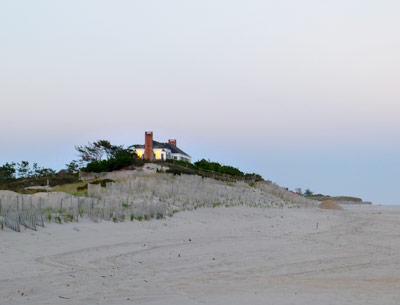Project in Dunes Headed for a Yes

Despite concerns about potential damage to the adjacent dune, Katherine J. Rayner appears likely to win approval from the East Hampton Village Zoning Board of Appeals to expand her house at 85 West End Road and build a basement underneath it.
At its meeting on Friday, the East Hampton Village Zoning Board of Appeals heard more lengthy and complex testimony on Ms. Rayner’s application, which calls for turning a 3-foot crawl space into an 8-foot deep, 525-square foot basement. The house is to be supported from below with cribbing as excavation occurred around the perimeter. A maximum of 21 temporary 4-by-4-foot pits would be dug, by hand, for concrete and steel rebar. Heavy construction machinery would be prohibited, with all work to be done by hand. Once the house is supported, the existing slab floor would be removed and a new concrete floor poured.
Ms. Rayner’s house is on a primary dune and is within a coastal-erosion hazard area.
Given the complexity of explanations of the construction methodology by Richard Warren of Inter-Science Research Associates, the board had left its June 28 hearing open pending a report from Robb Herrmann, a coastal management specialist at En-Consultants, who the board enlisted to provide an independent review.
Mr. Herrmann gave his support to the proposed construction methodology, with a few caveats. Mr. Warren, he said, had met with him at the property to provide a description of the construction methodology, which had been devised with assistance from Lee Weishar, a coastal engineer from the Woods Hole Group in Falmouth, Mass. “I found that very helpful, being able to have that discussion in the context of the site,” Mr. Herrmann said Friday.
Mr. Weishar’s evaluation, Mr. Herrmann said, describes the three most likely ways that such a construction project could adversely impact the stability of the dune. One is direct disturbance through the use of heavy equipment, which would not be involved in the proposed project. Another is through an increase in ground pressure, “resulting from additional weight being added adjacent to the coastal bank or dune face to the point that the resulting weight would exceed the supporting capacity of soils, leading to a collapse or destabilization of the dune,” he said. “If I understand Dr. Weishar’s report correctly, he goes so far as to suggest that this project, through the deepening of the basement of the west wing of the dwelling through the extension of the foundation walls, will actually help to increase the stability of the soils adjacent to the bank.”
While he found Dr. Weishar’s logic “compelling,” he said that, not being a professional engineer, he cannot speak to that particular assertion, but would be surprised that “a deepened basement would affect the overall ground pressure or the stability of the site one way or the other.”
Lastly, he said, the potential for the project to increase groundwater discharge through the side of the dune, resulting from an increase in groundwater recharge adjacent to the dune, was unlikely. This phenomenon, he said, occurs as a result of “groundwater collecting on what is typically a shallow-perched water table due to the presence of clay or some other impervious soil, such as when that perched table gets overcharged, water is moving laterally faster than it’s going down vertically, so it looks to find its way out.” The path of least resistance, he said, is usually out the side of the dune, resulting in erosion.
In his understanding of the project, he said, “there’s nothing . . . that would create that kind of additional volume to the system, because you’re not adding to the footprint.” This would only become an issue, he said, “if the deepening of the basement created a new physical impingement on the groundwater table, “where you would actually be displacing part of the water table and forcing an expedited lateral movement of water.”
Mr. Warren, who provided additional testimony after Mr. Herrmann’s presentation, said that a test hole had been dug on the property and its findings would be presented to the board. “You probably have at least 10 feet below the basement level before you even encounter groundwater,” he said.
Assuming the groundwater presents no problems, Mr. Herrmann summarized, the proposed construction methodology “has been designed appropriately to avoid impacting the dune, provided the execution of the process does not go awry in some way that would directly impact the structural integrity of the west wing of the house.” His sole concern, he said, would be that the pace of construction be controlled so that there are not an excessive number of pits opened around the foundation’s perimeter at any given time. “In my experience, that’s the problem 75 percent of the time,” he said. “The plans are designed well, but when you get out in the field, they don’t always go that way.”
“What you’re saying is we need to pin down methodology,” Frank Newbold, the board’s chairman, said to Mr. Herrmann.
“I think so,” was the reply.
Mr. Warren said that the project’s engineer, Andrew Renfroe of Blue Sky Design Inc., its architect, the Cicognani Kalla firm, and its contractor, Ben Krupinski, had jointly developed the plan of action. Mr. Krupinski and Mr. Renfroe will meet before the project’s commencement, he said, “to make sure that everybody understands this is the protocol we’re going to follow.” Mr. Renfroe, he said, will oversee the work and make periodic inspections of the property.
Mr. Newbold took an informal poll of the board, with reactions suggesting approval of the project. A determination is expected at the board’s next meeting on Friday, Oct. 25. Taking Mr. Warren’s suggestion, Mr. Newbold said that approval would be specifically contingent on the proposed methodology being followed.
